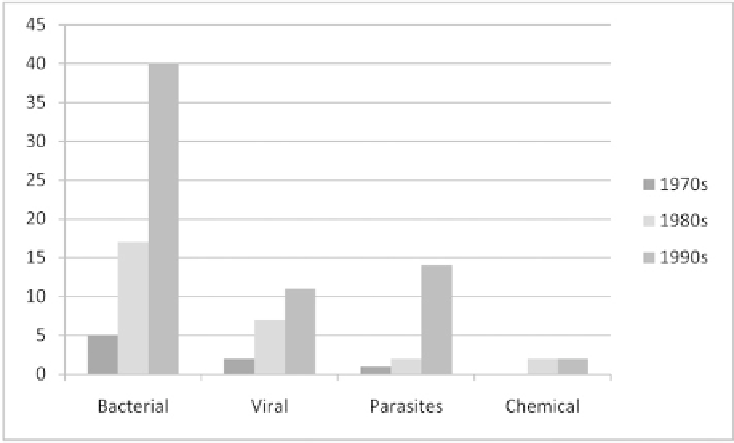Agriculture Reference
In-Depth Information
• The number of fresh produce - associated outbreaks steadily increased and more than
doubled.
• The number of people affected in these outbreaks more than doubled.
• Produce outbreaks, as a proportion of outbreaks associated with known vehicles,
also increased.
• A wide variety of fresh produce items were involved in the outbreaks.
• Bacteria, viruses, and parasites were identifi ed as causative agents.
• Both domestic and imported fresh produce items were implicated in outbreaks.
• Due to complicated packing and repacking schemes, as well as the perishability of
the products, tracing outbreaks back to their source was very diffi cult.
Figure 5.1 illustrates the increase in produce-associated outbreaks by category of
causative agent and by decade from the 1970s through the 1990s (Tauxe 2008).
Figure 5.2 depicts the number of produce-associated outbreaks (72) and illness
(8,791) in the U.S. by year, from 1996 to 2008, compiled by the Center for Food
Safety and Applied Nutrition (CFSAN) of the U.S. Food and Drug Administration
(FDA) in 2008 (Vierk 2009). The data in Figure 5.2 and all subsequent data compiled
for produce-associated foodborne illnesses by FDA 1) represents only those outbreaks
and illnesses associated with FDA-regulated foods, 2) do not contain information on
outbreaks/illnesses where the point of contamination is a retail food setting or home,
3) do not include illnesses transmitted from person-to-person, and 4) do not include
illness that may have occurred but were not recorded.
From the FDA data provided in Figure 5.2, it can be seen that produce-associated
outbreaks have fl uctuated from between 1 to 10 incidents per year from 1996 to 2008
and have involved from 57 to 1,702 people (Vierk 2009). According to the FDA,
Figure 5.1.
Produce-associated outbreaks by causative agent and decade (Tauxe
2008).






